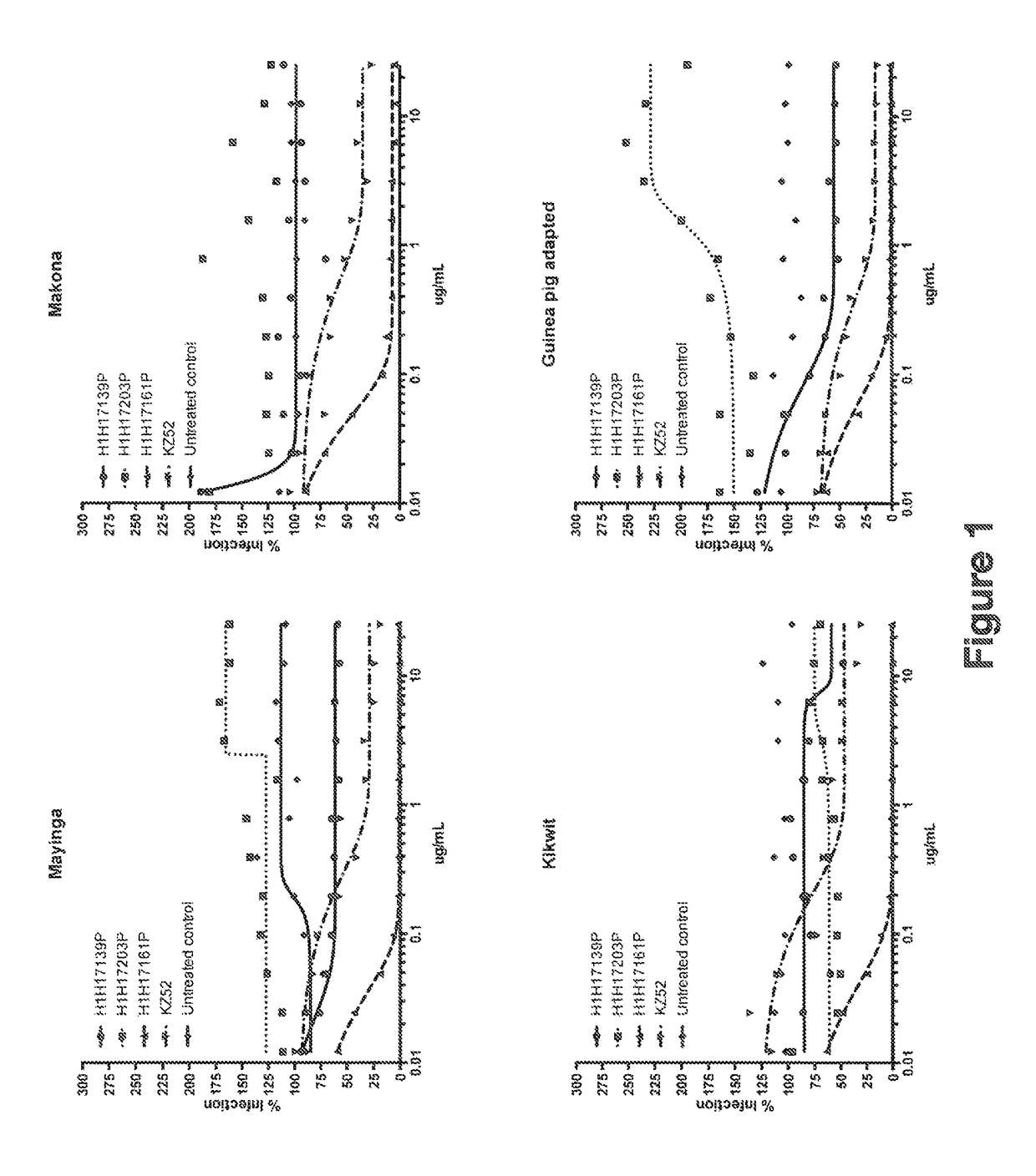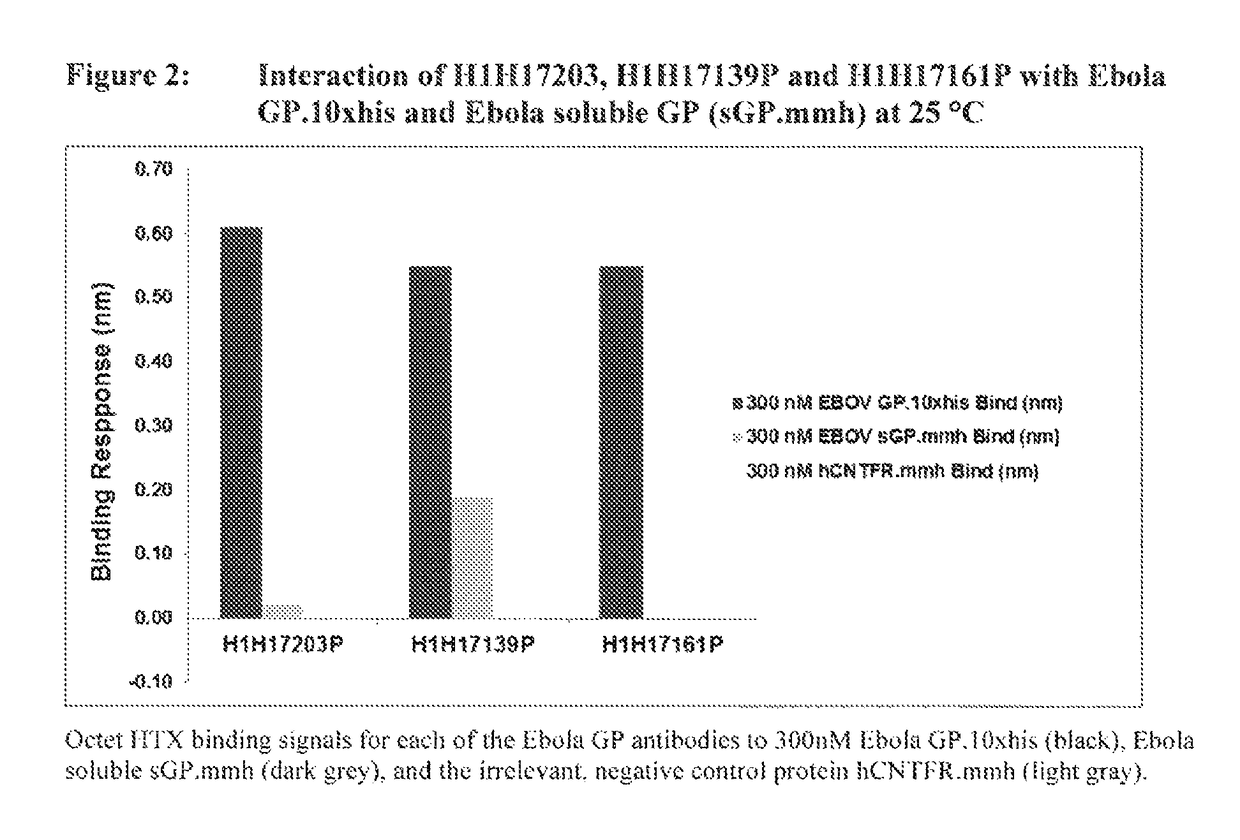Human antibodies to ebola virus glycoprotein
a technology of ebola virus and glycoprotein, which is applied in the field of antibodies, can solve the problems of not being advantageous to patients and no human treatment approved for human use, and achieve the effects of blocking the attachment of ebola virus, preventing the entry of ebola virus, and inhibiting or neutralizing the activity of ebola virus
- Summary
- Abstract
- Description
- Claims
- Application Information
AI Technical Summary
Benefits of technology
Problems solved by technology
Method used
Image
Examples
example 1
n of Human Antibodies to Ebola Virus
[0228]Human antibodies to Ebola virus were generated in a mouse comprising DNA encoding human immunoglobulin heavy and kappa light chain variable regions. In one embodiment, the human antibodies to Ebola virus were generated in a VELOCIMMUNE® mouse. In one embodiment, Veloclmmune® (VI) mice were immunized with DNA encoding the full-length Ebola virus GP [Zaire ebolavirus 2014 (GenBank: KJ660346.2)]. Antibodies were generated following an accelerated regimen comprising 2 immunizations separated by 2 weeks. The antibody immune response was monitored by an Ebola virus GP-specific immunoassay. For example, sera were assayed for specific antibody titers to purified full-length EBOV GP, subunit GP proteins (GP1 and GP2), and virus-like particles (VLPs) expressing EBOV GP. Antibody-producing clones were isolated using both B-cell Sorting Technology (BST) and hybridoma methods. For example, when a desired immune response was achieved, splenocytes were har...
example 2
Light Chain Variable Region Amino Acid and Nucleotide Sequences
[0231]Table 1 sets forth the amino acid sequence identifiers of the heavy and light chain variable regions and CDRs of selected anti-Ebola virus antibodies of the invention. The corresponding nucleic acid sequence identifiers are set forth in Table 2.
[0232]
TABLE 1Amino Acid Sequence IdentifiersAntibodySEQ ID NOs:DesignationHCVRHCDR1HCDR2HCDR3LCVRLCDR1LCDR2LCDR3H1H17134P246810121416H1H17139P1820222426283032H1H17142P3436384042444648H1H17151P5052545658606264H1H17161P6668707274767880H1H17162P8284868890929496H1H17193P98100102104106108110112H1H17196P114116118120122124126128H1H17199P130132134136138140142144H1H17203P146148150152154156158160H1H17214P162164166168170172174176H1H17219P178180182184186188190192H1H17223P194196198200202204206208H1H17228P210212214216218220222224H1H17354N226228230232234236238240H1H17356N242244246248250252254256H1H17357N258260262264266268270272H1H17358N2274276278280282284286288H1H17359N29029229429629830030...
example 3
Binding to Ebola Virus GP as Determined by Surface Plasmon Resonance
A. pH Dependent Dissociation Rate Constant at 37° C.
[0235]Binding dissociation rate constants (kd) and dissociation half-lives (t1 / 2) for Ebola virus GP binding to purified anti-Ebola virus GP monoclonal antibodies at 37° C. were determined using a real-time surface plasmon resonance biosensor assay on a Biacore T200 instrument. The CM4 Biacore sensor surface was derivatized by amine coupling with a monoclonal mouse anti-human Fc antibody (GE, # BR-1008-39) or monoclonal goat anti-mouse Fc antibody (GE, # BR-1008-38) to capture purified anti-Ebola virus GP mAbs. All Biacore binding studies in Example 3A were performed in a buffer composed of 0.01M Na2HPO4 / NaH2PO4, 0.15M NaCl, 0.05% v / v Surfactant P20 (PBS-P running buffer) at pHs 7.4, 6.0 and 5.0. The low pH chase was performed to assess whether the antibodies maintain binding at low pH. This would mimic the conditions that the virus will encounter during membrane f...
PUM
| Property | Measurement | Unit |
|---|---|---|
| dissociation constant | aaaaa | aaaaa |
| equilibrium dissociation constant | aaaaa | aaaaa |
| pH | aaaaa | aaaaa |
Abstract
Description
Claims
Application Information
 Login to View More
Login to View More - R&D
- Intellectual Property
- Life Sciences
- Materials
- Tech Scout
- Unparalleled Data Quality
- Higher Quality Content
- 60% Fewer Hallucinations
Browse by: Latest US Patents, China's latest patents, Technical Efficacy Thesaurus, Application Domain, Technology Topic, Popular Technical Reports.
© 2025 PatSnap. All rights reserved.Legal|Privacy policy|Modern Slavery Act Transparency Statement|Sitemap|About US| Contact US: help@patsnap.com



